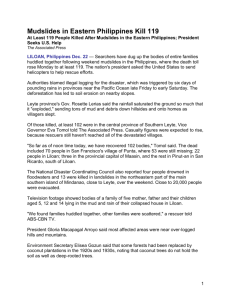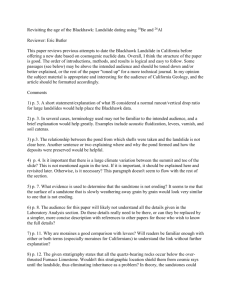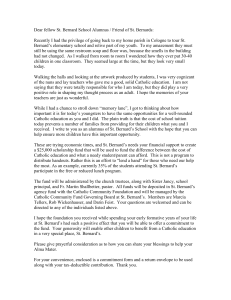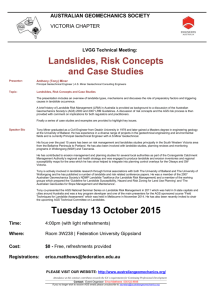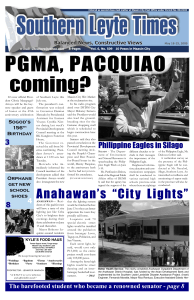Leyte Mudslide - The Philippine Reporter
advertisement
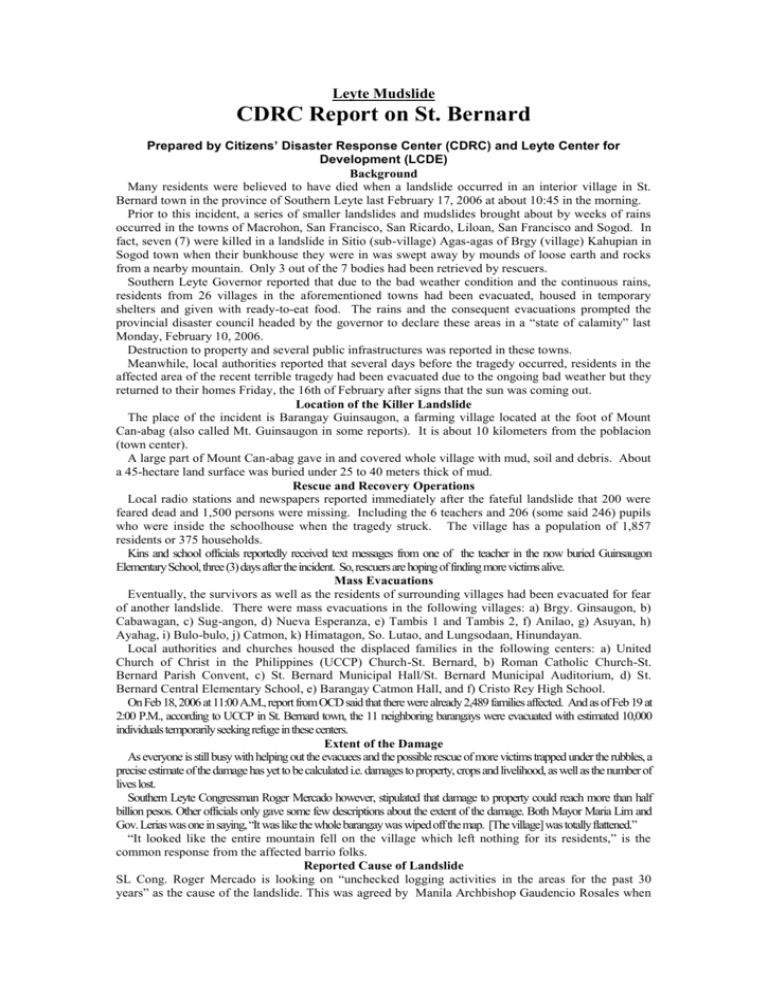
Leyte Mudslide CDRC Report on St. Bernard Prepared by Citizens’ Disaster Response Center (CDRC) and Leyte Center for Development (LCDE) Background Many residents were believed to have died when a landslide occurred in an interior village in St. Bernard town in the province of Southern Leyte last February 17, 2006 at about 10:45 in the morning. Prior to this incident, a series of smaller landslides and mudslides brought about by weeks of rains occurred in the towns of Macrohon, San Francisco, San Ricardo, Liloan, San Francisco and Sogod. In fact, seven (7) were killed in a landslide in Sitio (sub-village) Agas-agas of Brgy (village) Kahupian in Sogod town when their bunkhouse they were in was swept away by mounds of loose earth and rocks from a nearby mountain. Only 3 out of the 7 bodies had been retrieved by rescuers. Southern Leyte Governor reported that due to the bad weather condition and the continuous rains, residents from 26 villages in the aforementioned towns had been evacuated, housed in temporary shelters and given with ready-to-eat food. The rains and the consequent evacuations prompted the provincial disaster council headed by the governor to declare these areas in a “state of calamity” last Monday, February 10, 2006. Destruction to property and several public infrastructures was reported in these towns. Meanwhile, local authorities reported that several days before the tragedy occurred, residents in the affected area of the recent terrible tragedy had been evacuated due to the ongoing bad weather but they returned to their homes Friday, the 16th of February after signs that the sun was coming out. Location of the Killer Landslide The place of the incident is Barangay Guinsaugon, a farming village located at the foot of Mount Can-abag (also called Mt. Guinsaugon in some reports). It is about 10 kilometers from the poblacion (town center). A large part of Mount Can-abag gave in and covered whole village with mud, soil and debris. About a 45-hectare land surface was buried under 25 to 40 meters thick of mud. Rescue and Recovery Operations Local radio stations and newspapers reported immediately after the fateful landslide that 200 were feared dead and 1,500 persons were missing. Including the 6 teachers and 206 (some said 246) pupils who were inside the schoolhouse when the tragedy struck. The village has a population of 1,857 residents or 375 households. Kins and school officials reportedly received text messages from one of the teacher in the now buried Guinsaugon Elementary School, three (3) days after the incident. So, rescuers are hoping of finding more victims alive. Mass Evacuations Eventually, the survivors as well as the residents of surrounding villages had been evacuated for fear of another landslide. There were mass evacuations in the following villages: a) Brgy. Ginsaugon, b) Cabawagan, c) Sug-angon, d) Nueva Esperanza, e) Tambis 1 and Tambis 2, f) Anilao, g) Asuyan, h) Ayahag, i) Bulo-bulo, j) Catmon, k) Himatagon, So. Lutao, and Lungsodaan, Hinundayan. Local authorities and churches housed the displaced families in the following centers: a) United Church of Christ in the Philippines (UCCP) Church-St. Bernard, b) Roman Catholic Church-St. Bernard Parish Convent, c) St. Bernard Municipal Hall/St. Bernard Municipal Auditorium, d) St. Bernard Central Elementary School, e) Barangay Catmon Hall, and f) Cristo Rey High School. On Feb 18, 2006 at 11:00 A.M., report from OCD said that there were already 2,489 families affected. And as of Feb 19 at 2:00 P.M., according to UCCP in St. Bernard town, the 11 neighboring barangays were evacuated with estimated 10,000 individuals temporarily seeking refuge in these centers. Extent of the Damage As everyone is still busy with helping out the evacuees and the possible rescue of more victims trapped under the rubbles, a precise estimate of the damage has yet to be calculated i.e. damages to property, crops and livelihood, as well as the number of lives lost. Southern Leyte Congressman Roger Mercado however, stipulated that damage to property could reach more than half billion pesos. Other officials only gave some few descriptions about the extent of the damage. Both Mayor Maria Lim and Gov. Lerias was one in saying, “It was like the whole barangay was wiped off the map. [The village] was totally flattened.” “It looked like the entire mountain fell on the village which left nothing for its residents,” is the common response from the affected barrio folks. Reported Cause of Landslide SL Cong. Roger Mercado is looking on “unchecked logging activities in the areas for the past 30 years” as the cause of the landslide. This was agreed by Manila Archbishop Gaudencio Rosales when he said, “The real reason for this terrible tragedy is that forests have been badly denuded and no serious replanting has been done. It is time for the powers-that-be to address strongly these issues. Otherwise incidents such as what happened [in St. Bernard] will be replayed again.” However, Director Renato Solidum of Philippine Institute of Volcanology and Seismology (PHIVOLCS) believes otherwise. He said, “The area could have really been ready for a landslide because of the amount of rainfall and if there was a minor earthquake, it might have hastened it…A 2.6 magnitude earthquake hit the southwestern portion of SL around 10:36 a.m.” Sec. Avelino Cruz of the Department of National Defense (DND) agrees with Solidum’s findings. He said, “In our initial findings, the heavy rains caused the landslides”. He also cited the report of Philippine Atmospheric Geophysical Astronomical Administration (Pag-asa) which says, “500 milliliters of rain in the area since Feb. 1 while the average of 127 mL of rain in February in Southern Leyte for the past 30 years”. He pointed out that 500 mL of rainfall is far above the holding capacity of the soil. Meanwhile, the Department of Environment wrote an official statement of their findings. It said: “Geologically, it (St. Bernard) is underlain by volcanic rocks characterized by intense fracturing and weathering…this makes it unstable and susceptible to mass movement”. “All three major factors of a landslide -the integrity of the bedrock, steepness of the slope and level or amount of precipitation - are present in the area”. “The rocks in the area are badly broken or fragmented, which are then prone to weathering and erosion… Constant rainfall could make water seep into the fractures of the rock mass…Excessive water from continuous rains could saturate the rock and soil materials with water and cause landslides.” Assistance Needed Search and Rescue Operations. Attempts to save lives were immediately conducted. However, rescuers encountered difficulty in their search-and-rescue operations. The soft and thick layer of mud rendered the heavy equipment sent by DPWH, mining firms and other government agencies useless. Rescuers dug out using their hands and simple tools. The continuous rains made the search-and-rescue operations even more difficult. The arrival and use of modern gadgets (ground sonar to detect human life underground) may help assess the possibility of finding survivors. Retrieval/Recovery of Dead Bodies. As the days passed, the chance of finding survivors under the 25-40-meter thick mud is getting slim. Seemingly, the search-and-rescue operations is somewhat transformed into retrieval operation of cadavers caught under the rubbles. Relief and Medical Assistance. Nineteen (19) injured survivors are currently receiving medical attention at the Anahawan District Hospital and at the Eastern Visayas Regional Medical Center (EVRMC) in Tacloban City. Those in the evacuation camps may need medical assistance as well as relief aid. Rehabilitation of the Victims. Thousands were rendered homeless in Brgy. Guinsaugon, Southern Leyte. Even the local authorities in the province discourage the return of survivors to this barangay. Moreover, a big amount of money is needed in the rehabilitation of the place to lessen if not eliminate the threat of landslides. Barangays situated on mountain slopes need infrastructures like dikes, canals, slope controls, etc. Our Call In behalf of the victims and their families, we are appealing for help. Particularly, please send in the following: 1. Financial/Monetary Support 2. Materials: • Clothes, Blankets, Mosquito Nets • Flashlights, Lamps • Cooking Utensils • Hygiène Articles (Soap, toothpast Medicines for various illnesses 3. Food: • Rice • Canned goods • Dried fish and other food items • Water, containers and water purifiers/tablets

